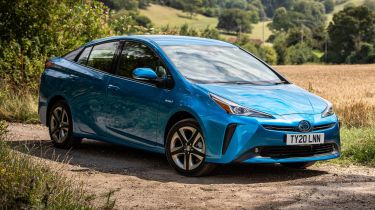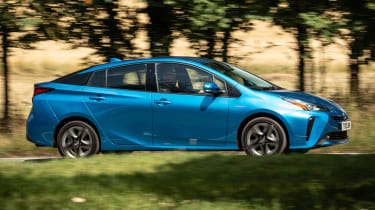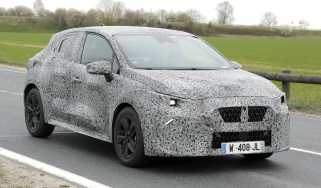Toyota Prius (2016-2022) review - MPG, CO2 and running costs
With superb fuel economy, low insurance costs and reassuring residuals, the Prius should be cheap to run

Just so you know, this is an archived review of the 2016-2022 Toyota Prius. If you are interested in information about the MPG figures of the latest Toyota Prius, or news about the latest Toyota models, please follow the links provided.
The main reason you would buy a Prius is that it’s a hybrid and, in theory, a hybrid equals great running costs. The Prius certainly delivers impressive mpg and emissions figures, especially on the standard 15-inch wheels, which are available across all trim levels if you want the best economy. Most trims also give you the choice of 17-inch alloy wheels, with a slight efficiency penalty - you can expect almost 60mpg from models with the bigger wheels, and up to 67mpg for standard versions. Choosing the all-wheel-drive Prius AWD will reduce the maximum fuel economy to 58mpg.
These are figures that very few diesel cars can match, let alone petrol models. The Prius is also slightly more economical than its nearest hybrid rivals, the Kia Niro and Hyundai Ioniq.
Meanwhile CO2 emissions start from just 94g/km, meaning company-car drivers will pay a lower rate of Benefit-in-Kind than a non-hybrid rival. Going for the bigger wheels or the all-wheel-drive version will both increase the Prius’ CO2 emissions up to almost 110g/km, resulting in BiK being several bands higher.
Used - available now

2020 Toyota
Prius
34,796 milesAutomaticPetrol1.8L
Cash £16,100
2018 Toyota
Prius
62,262 milesAutomaticPetrol1.8L
Cash £11,963
2020 Toyota
Prius
38,900 milesAutomaticPetrol1.8L
Cash £16,951
2020 Toyota
Prius
50,351 milesAutomaticPetrol1.8L
Cash £17,500Whether you’ll reach anywhere near those claimed economy figures will depend entirely on how and where you drive your Prius. The Prius is a common sight in big cities, and this is the best environment for the car.
For those who commute mostly in and around the city, you should be able to hit in excess of 70mpg if you are light with the throttle and use EV mode often. However, if you use a lot of motorways or fast A and B-roads, you’ll be looking at around 50mpg.
The Prius features an EV button, but there’s not much point in using it. Toyota admits this function is a hangover from the first hybrids, with the US market wanting an all-electric mode at the touch of a button. The Prius boosts efficiency by using electric power to support the petrol engine, rather than replace it, so it’s best to let the software intelligently manage the switch between the two modes.
Long-term running costs have been particularly good on older Prius models and the latest one should be no different. The Prius has earned itself a reputation – especially from fleets – for being cheaper to run than conventional cars in some cases.
Due to it being a hybrid, owners have reported replacing fewer consumable items like brake pads compared to normal petrol-engined cars, while the fringe benefit of Toyota's rock-solid reliability is also a major factor in these low running costs.
If you’re after the ultimate in fuel efficiency, though, the regular Prius can be trumped - and in some style - by the Prius Plug-in. It uses lithium-ion batteries to store more electricity for the car’s systems, and can therefore travel for up to 30 miles without firing up the combustion engine at all. That makes it a perfect tool for those who spend most of the week driving around town, but who need to make longer journeys from time to time. Unlike the Hyundai Ioniq, though, there’s no electric Prius version.
There’s no denying the benefits of that larger battery, too, because it plays right into the hands of the official fuel economy and CO2 tests. In the old tests, the Prius Plug-in returned 283mpg and 22g/km of CO2, but under WLTP tests these figures are now 235mpg and 28g/km. Whichever figures you use, it must be said that you’ll have to drive in a very specific, gentle fashion if you’re to get close to matching those fuel consumption numbers in the real world.
If you're intent on maximising your fuel economy, the Plug-in can be upgraded with a solar roof panel that can keep the battery topped up. However, it's only available on Business Plus models, and you lose valuable safety kit such as the head-up display, blind-spot monitoring and rear cross-traffic alert.
Regular use around town, on a full charge, should yield 100mpg quite easily, however. A bigger problem could be the latest VED rules, which see the Plug-in charged the same road tax as the regular Prius, eliminating some of the long-term ownership appeal of the plug-in model. The plug-in hybrid Prius is also more expensive to buy in the first place, so you’ll need to regularly plug it in to claw back some of that extra initial outlay.
Insurance
Insurance premiums shouldn't be too expensive for the Prius, as all cars sit in either group 13 or 14. Opting for the plug-in hybrid version will mean paying out a little more for insurance cover due to its group 20 rating.
Depreciation
Over a typical three-year/36,000-mile ownership period, our experts have calculated residuals of 61-67% for the regular Prius, with the entry-level Active version the top performer. Go for the Plug-in model, and residuals are slightly poorer at 53-55%. Second hand prices will probably be higher in cities like London as the Prius is viewed as a favourite amongst minicab and private hire businesses.







